Stories and history at Oakwell Hall
Discover Oakwell's claims to fame including its growing television stardom as a filming location, its unique Bronte connections, the mysterious ghost story and important civil war involvement.
Oakwell stories
The significant Battle of Adwalton Moor took place famously close to Oakwell. The Parliamentary cause in the North was led by the Fairfax family and concentrated in the cloth towns of West Yorkshire; the Royalists were led by the Earl of Newcastle.
In June 1643 the Earl of Newcastle marched on Bradford with 10,000 men. To defend the town from siege, the Fairfaxes advanced from Bradford with 3-4,000 men and gave battle on Adwalton Moor. The Royalist pikemen and cavalry pushed the Parliamentarians back and into flight. The victory meant Royalist control of the North for the year.
At the time of Civil War, John Batt was owner of Oakwell; he lived a colourful and adventurous life. He was a JP and a friend of Sir William Savile of Thornhill Hall. Pursuing the life of a gentleman, he hunted, dined, socialised and did business with other local and greater gentlemen than himself. He made improvements to Oakwell to create a home in keeping with his rising status.
Civil War marked a turn in the family's fortunes. John Batt was a Captain in Sir William Savile's regiment and fought on the side of the Royalists. When the war ended, his Royalist sympathies resulted in a fine of one tenth of the value of his estate, over three hundred and sixty pounds which, despite appeals to Parliament, he had to pay.
Perhaps financial difficulties drove John to seek his fortune in the New World. He set sail around 1648 to Virginia with three of his sons. A business venture with Sir Thomas Danby of Farnley, arranging transportation of settlers, was unsuccessful, with an acrimonious money dispute. John's eldest son drowned on the return voyage: the affair was a personal tragedy and a business failure for the Batts.
The mystery of the bloody footprint.
An old Oakwell legend tells the story of the ghost of William Batt, owner of the house in 1684. William was a bachelor of 25 years of age, whose widowed mother, Elizabeth, lived at Oakwell. Mrs Gaskell in her 'Life of Charlotte Bronte', 1857 tells the story:
"Captain Batt was believed to be far away, his family was at Oakwell; when in the dusk one winter evening, he came stalking along the lane, through the hall and up the stairs, into his own room, where he vanished. He had been killed in a duel in London that very same afternoon of December 9th 1684."
The legend states that William left a bloody footprint behind in his bedroom.
William was indeed in London on 9 December 1684, at the Black Swan Inn, Holborn where he borrowed money. A local diarist recorded his death 'in sport' and that he was 'lain by Mr Gream'. William was buried in Birstall on 30 December 1684.
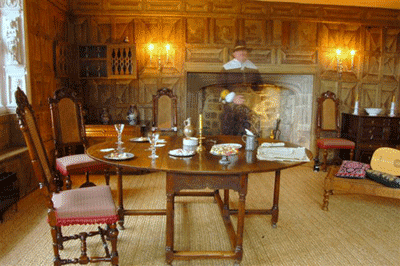
In the 19th century, a series of girls' and boys' boarding schools occupied Oakwell Hall. It was while one of these schools was in residence that Charlotte Bronte visited.
Charlotte had been a pupil at Roe Head School near Mirfield, where she made two very close friends: Ellen Nussey of Birstall and Mary Taylor of Red House, Gomersal.
Ellen Nussey's cousins - Hannah Cockhill and her daughters - ran a girls' school at Oakwell and it is believed that Charlotte visited with Ellen. The visit obviously made a strong impression on Charlotte and in her novel Shirley, Oakwell Hall became Fieldhead - the home of the heroine.
She also described the interior:
'Mr and Mrs Helstone were ushered into a parlour: of course as was to be expected in such a gothic old barrack, this parlour was lined with oak: fine dark, glossy panels compassed the walls gloomily and grandly.'
At the time of Charlotte's visits, some of the traditional oak panels had been painted over in 'a delicate pinky white.'
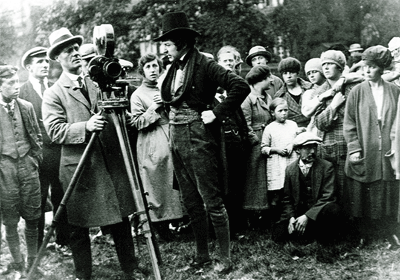
The history of Oakwell Hall
Built in 1583, this Elizabethan manor house has delighted visitors for centuries. Charlotte Bronte visited it in the 19th Century and featured it as Fieldhead, the home of the eponymous heroine in her novel Shirley.
"It was neither a grand nor a comfortable house; within as without it was antique, rambling and incommodious."
Charlotte Bronte's description of 'Fieldhead' (Oakwell Hall) in her novel 'Shirley'.
Oakwell represents a typical local compromise - a mix of local Yorkshire building and fashionable gentry style reflecting the status of its owners, the Batt family. From the front it looks much as when built in the late 16th Century. The date of construction, 1583, is carved in the wall above the porch doorway, with the initials of owner John Batt. John employed local builders working in materials available locally, including oak. Work was in stages, the central hall preceding the West Wing
Within the stone building is heavy timber framing, once thought to be an earlier timber-framed house encased in stone. Recent research and scientific analysis by tree ring dating suggest instead that the builders adopted a mixed form of construction, using stone but including some timber framing in a 'belt and braces' approach. The massive roof tie beams spanning the Great Hall were felled in spring 1583 (as on the porch datestone), while West Wing timbers are from 1586 (with reused wood from 1501). The hall and west wing roofs are partly supported by timber posts extending to the ground.
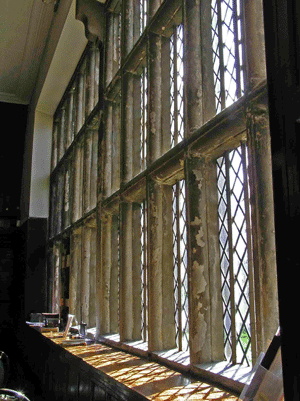
In medieval times Oakwell was a small farming community. The hall was built during the reign of Elizabeth I, but replaced an earlier timber dwelling. Archaeological excavations uncovered foundations of structures from the 14th and 15th Centuries, probably a kitchen and bakehouse; also a moat - stretches are preserved in the modern water courses.
John Batt's grandson, also John, probably removed the 'hall chamber' and created the magnificent hall window in the mid 17th century, making improvements appropriate to his status before the hardship of Civil War ended such extravagance. The original hearth at the east end of the hall was replaced by a fireplace in the north wall. The early 17th Century may have been when the north-west wing was built to provide additional service rooms. The hall wall and stair tower may also be modifications. The chimney stack was built in the mid-17th Century.
Later alterations included some sliding sash windows, fireplaces and changes when a 19th Century school. From the late 18th to early 20th Centuries, Oakwell was occupied by tenants with no incentive to make substantial changes, so it retains much of its original character and many original fittings.
Oakwell has a central hall with cross wings at each end. The porch leads into a cross passage which runs right through the building, separating the hall from the east wing. Oakwell features a high main hall, but an inventory of 1611 records a 'hall chamber', indicating there was once a room above the hall which no longer exists.
What might be expected to be the east 'service wing' in fact contains the 'New Parlour', a living room facing south to catch the sun. The west Great Parlour wing of the house contains a mixture of living and service rooms, including milk house and butteries. It is likely that the service rooms were originally in the east wing, but moved when the 'new parlour' was created.
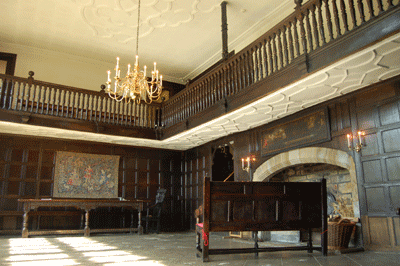
Although there were later alterations, such as the removal of the great kitchen fireplace, the house is essentially the same as it was in the 17th century. A 1611 inventory gives an idea of what each room might have been used for.
Ground floor living rooms or 'parlours' range from the opulent Great Parlour, with table, eight stools and maps of foreign countries, to the Maids' Parlour, with two full beds and one bed frame. The dual use of ground floor rooms as living and bedrooms was usual at this time; by the end of the century bedrooms had moved upstairs. Also on the ground floor were service rooms needed to maintain the household - kitchen, buttery, inner buttery, milk house and a tavern for wine and beer, with cheese press. Upstairs rooms included the Kitchen Chamber, used for dry food storage because of the rising heat from the kitchen below. Other chambers were bedrooms while two small studies contained Robert Batt's collection of books.
The inventory has shortcomings as it was drawn up by household steward, John Matteson, as a record Robert Batt's property when the house was let to a tenant. It is only a partial record of furnishings of a gentleman's home - we do not know what the tenant brought with him.
As Charlotte Bronte observed, Oakwell is not a grand house, but it does contain interesting decorative detail. Classical Tuscan columns in the hall were popular in the Elizabethan era when architect Robert Smythson used them in grand mansions. By the 17th century the use of classical motifs had filtered down to the local builders employed by the Batts, including the caryatid (female figure) found on the side of windows in the Great Parlour.
Visitors admire the fine oak panelling, so appealing to Americans in the early 20th century that it almost led to the dismantling of the house for shipment overseas. Plain panelling was acceptable to John Batt and his grandson, but became unfashionable. Expensive woods like walnut were being used and wealthy families were replacing their panelling. The Batts saw the new fashions in York and London and employed craftsmen to modernise their panels.
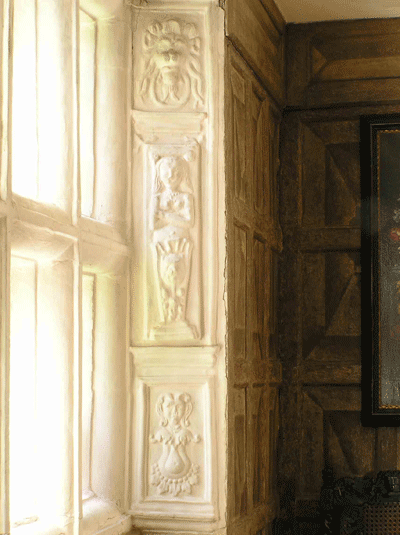
The Great Parlour and an upstairs parlour were stencilled and scumbled to represent figured wood in a large, geometric design, a three-dimensional effect especially convincing in candlelight. By the 19th Century, the design was concealed by paint of, according to Charlotte Bronte,'' a delicate pinky white'. To restore the panelling, today's craftsman removed three thick layers of paint.
The largest 17th century feature no longer survives - the magnificent Great Parlour ceiling was smashed by a falling chimney during a storm in 1883. Fortunately Victorian artists had sketched the design. Bearing local motifs including acorns, caryatids, fruit, vines and griffins, the ceiling probably dated from the 1620-30s when skilled plasterer Francis Lee was working in the area. It also incorporated the rather sinister design of the Batt family coat of arms - three bats with wings outstretched.
When John Batt built Oakwell Hall in 1583 it dominated the landscape and established the Batts as one of the area's leading gentry families. Their adventurous and colourful story is fascinating.
Early Batts - Henry and his son John.
The acquisition of the manor of Oakwell, with land in Heckmondwike, Gomersal and Heaton, marked a significant rise in status for this entrepreneurial family who acquired their fortune through business interests in Halifax in previous centuries. Some notoriety characterised the earlier Batts, implicated in a plot to steal and melt down the church bell and demolish the rectory for its stones! Money to build a school was also diverted.
Robert Batt
John's son, like several Batt sons attended university. A letter by Robert in 1595 has interesting snippets about life as a scholar - 'the small pokes (smallpox) doe still continue amongst us and doe endainger many'. Robert lived in Wiltshire, leasing Oakwell to his cousins.
John Batt
Robert's son, died 1652 pursued the life of a gentleman at Oakwell; he hunted, dined, socialised and did business with other local gentlemen. John fought as a Royalist in the Civil War. The place of John's death is uncertain, an administration of his will states that he died 'in parts beyond the seas'.
Wiliam Batt
John's grandson, died 1684 - A violent young death and a ghostly mystery - discover The Ghost of Oakwell
John Batt
William's brother, died 1707 was a bachelor until late, when he married Henrietta Metcalf in York Minster. They had no children - when John died in 1707 the family name died with him.
In 1747 parts of the estate were sold and a new era in Oakwell's history began. However a branch of this remarkable family thrived in America, and today family members travel to visit their ancestral home.
When the Batts sold Oakwell in 1747, Benjamin Fearnley, a lawyer, borrowed heavily to buy it. His son Fairfax found the debt a heavy burden and had to sell in 1789. Absentee landlords then rented the house to a series of families and schools until 1929.
While a girls' boarding school was in residence in the 1840s, Charlotte Bronte visited Oakwell, which inspired the house Fieldhead in her novel Shirley.
In 1861 it was a boys' boarding school. Henry Millard aimed to 'ground his pupils thoroughly in the subjects considered essential at the Oxford and Cambridge Local Examinations.'
Two decades later, the Carter sisters ran a school. In 1883, the elder Miss Carter was asleep in the Great Parlour Chamber when a tremendous storm brought the chimney crashing through the roof and into the Great Parlour below, destroying the highly decorative ceiling.
After that the most notable tenant was George Maggs, a Batley solicitor. Photographs show the hall displayed in 'baronial' style with antlers and stags heads adorning the balcony.
The landlords decided to sell the hall in 1926. Rumours were rife that it was to be taken down, stone by stone, and shipped to America. In 1928 after a public appeal two wealthy benefactors, Sir Henry Norman Rae and John Earl Sharman bought it for £2,500 and gave it to Batley Corporation.
The rest of the estate remained in private hands and the cottages near the hall were a farm house until the 1970s, when it was bought and Oakwell Hall Country Park came into being.
Today Oakwell is displayed as the 1690s Batt family home. The rooms are furnished with a mixture of original and reproduction furnishings to show the lifestyle of a lesser gentry household.
When first opened as a museum, the public were disappointed there was little to see and complaints appeared in the press:
'...a scene of almost indescribable solitude and coldness ... A bare stone floor, signs of decay and need for renovation, and a balcony that one could imagine might fall at any moment.'
Objects were gradually acquired and after an appeal in 1939, the collection grew. By the 1960s Oakwell had a large collection, including fine pieces on loan from the Victoria and Albert Museum.
Displays then depicted a variety of periods, but in the mid 1980s, following a detailed research project, the displays were reorganised and Oakwell Hall became furnished as the stunning late 17th Century home visitors experience today.
Was this information useful?
We'd like your feedback to improve the Kirklees Council website and the information we provide.




